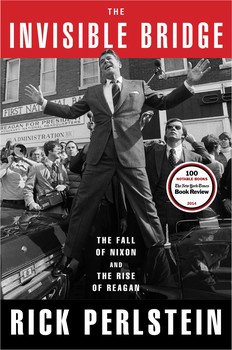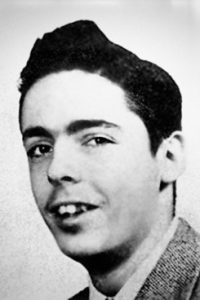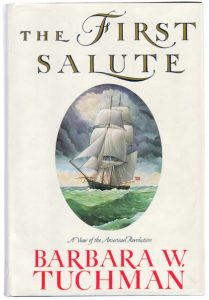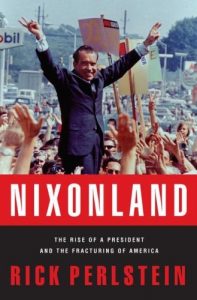Rick Perlstein
Review by Dan Geddes
13 March 2015
The Invisible Bridge is a guilty pleasure for those who enjoy 1970s nostalgia.
It chronicles that time of serial debacle (1973–1976) between Watergate and the election of Jimmy Carter, an era when Americans were deeply and publicly suspicious of their institutions. Many people were looking for a savior from the uncertainties of the age, and Ronald Reagan served that function for many in 1976.
The Invisible Bridge continues Perlstein’s multi-book project depicting the American conservative movement in the culturally liberal period of the 1960s and 1970s. Including the earlier books, Before the Storm: Barry Goldwater and the Unmaking of the American Consensus and Nixonland, his enthusiastic studies in conservatism now run more than 2,000 pages. His next book will cover the four years before Reagan’s election in 1980.
His thesis is that American politics had grown so cynical in the aftermath of Vietnam, Watergate, and the Church Committee hearings (on CIA abuses of power), that Ronald Reagan’s optimistic brand of neo-conservatism found its national voice in 1976, a time when Congress and the nation as a whole seemed overwhelmingly Democratic.
These years were plagued by an onslaught of troubling events, including the POW/MIA episode, acts of domestic terrorism, hearings on CIA abuses, Patty Hearst’s kidnapping, the sudden doubling of meat prices and sharply higher oil prices.
There were frequent (botched) assassination attempts on Ford. He wasn’t the type of leader to restore America’s faith in its institutions, especially after pardoning Nixon. Ford had been appointed Vice President, and so ascended to the Presidency upon Nixon’s resignation. Ford had never been elected by anyone outside of his own Michigan congressional district and so seemed to lack a popular mandate. He started literally falling down in public, and was ridiculed for it by Chevy Chase on the new TV sensation, Saturday Night Live (Perlstein even covers the development of Chase’s Ford parodies).
Former California governor Ronald Reagan emerged as a challenger to nearly win the 1976 Republican nomination from the incumbent Ford. Many conservatives found Ford’s conservative credentials lacking and Betty Ford’s public profile to be brazenly liberal, and so turned to Reagan as their spokesman.
Democrats and many others turned to the unlikely candidacy of Jimmy Carter, whose carefully cultivated outsider image gave him credibility as a tribune of the people. Perlstein enjoys showing Carter’s equivocations as he plays both sides of the political spectrum.
Reagan inspired enthusiasm among conservatives (who loathed liberal Republican Nelson Rockefeller), and Ford had to use every trick available to his political machine to fight off a near dramatic upset by Reagan during the 1976 Republican convention.
Reagan reaffirmed America’s overall innocence by repeatedly downplaying the importance of Watergate. He also called for the reassertion of American power: America hadn’t been playing hard enough to win in Vietnam; America should not just give back the Panama Canal, or to pursue détente with the Russians.
Reagan is the “hero” in this chronicle of conservatism by the liberal Perlstein. A biography of Reagan is included in early chapters. Reagan’s career–from sports broadcasting, to B-movie Hollywood actor, to president of the Screen Actors Guild, FBI informant about Hollywood communists, General Electric spokesman, TV star, and conservative governor of California–is now familiar to many.
Reagan finally found his political voice while eloquently supporting Goldwater in 1964. The book highlights Reagan’s unwavering optimism in the face of oppositions, his blithe indifference to his own contradictions, and his constant effort to shape how he was being perceived.
#
There has long been a consensus in America that journalism should strive to be “objective,” not like the party organs that dominated 19th and much of 20th century journalism. The same goes for history; many readers prefer historians who appear to be impartial. Perlstein sometimes lets his disdain for Nixon and Ford and other Republicans go too far. And while he balances it by reveling in the absurdities in Jimmy Carter’s campaign, or Governor Jerry (“Moonbeam”) Brown’s candidacy, there is a noticeable difference in the handling of conservatives that may irritate some readers.
Perstein’s deep research–especially into the newspapers and magazines of that time–is artfully arranged and written. He presents a political thesis or two, but offers relatively few original interpretations in his large volume. He selects and summarizes the media treatment of political turning points during these years, week-by-week or day-by-day, so that readers can relive this time of national doubt.
He includes the public reaction to touchstone movies such as M*A*S*H, The Godfather, The Exorcist, The Conversation, Jaws, Nashville, and even The Bad News Bears (where the losing kids drink beer at the end); as well as TV shows, such as M*A*S*H, All in the Family, and Saturday Night Live, and among other culturally divisive fare.
Even more shocking for many were the revelations by Senator Frank Church’s Senate Select Committee on Intelligence, which uncovered the CIA’s assassination of foreign leaders, the agency’s suspected role in the Watergate break-in, domestic spying, and its amazing “heart attack gun” which some saw as a subtle reminder to the Senate that the shadow government was still in charge:
And so, for those few scattered Americans seriously following the intelligence investigations, a fundamental and fundamentally disturbing question lingered: Were our presidents lawless and wicked? Or just bumbling nobodies, Gerald Fords, every last one of them — dumb, ignorant pawns of the secret police agencies?
To ask the question was to stare into the abyss. (537)
Maybe one wouldn’t think that electing Ronald Reagan to the Presidency would alleviate those fears, but in fact, Reagan’s confidence and charm were just what a large sector of the electorate was looking for: reassurance that America still retained its innocence and its place as the greatest country in the world.
Americans had grown cynical during this tumultuous time in American life. Many Americans didn’t want to belong to the “suspicious circles” that questioned America (or even its leadership), who might now be labeled “conspiracy theorists” even for doubting what one reads in the newspapers.)
In the 1970s, liberals were critical of American institutions, hoping the country could be more just, maybe more like Western Europe. Conservatives thought nothing was wrong with America. America should wield power to preserve its brand of freedom.
Perlstein clearly delights in showing us the new stars of the new right: Dick Cheney, Ford’s chief of staff; Donald Rumsfeld, mastermind of the surprising “Halloween massacre” (the sudden re-shuffle of Ford’s staff, including reducing Kissinger’s role); Jesse Helms’ rise to prominence; the early political antics of future Republican leaders such as Karl Rove and Trent Lott.
In his source notes, Perlstein describes how he used Google to access newspaper archives (as he had formerly used library and microfiche material). It’s a bit disappointing that the source notes are not printed in the book at all, but are only available online. With Nixonland it was pleasurable just to read through the source notes, or flip between the text and the notes.
The Invisible Bridge is still a fun chronicle for those who wish to read 800 pages about four action-packed years in the mid-1970s.
13 March 2015
The Invisible Bridge – Reviews
“The Uses of Division” by George Packer, The New Yorker.
“A Distant Mirror: ‘The Invisible Bridge’ by Rick Perlstein” by Frank Rich, The New York Times.
“The ‘Bridge’ From Watergate To Reagan, Masterfully Drawn” by Michael Schaub, National Public Radio.
“The Gonzo Historian” by Sam Tanenhaus, The Atlantic.











Be First to Comment